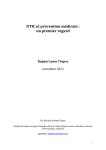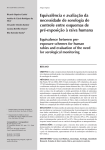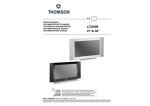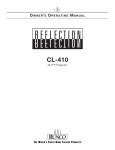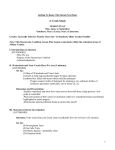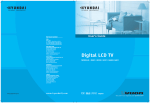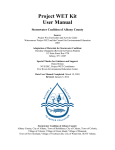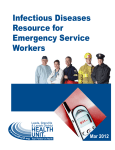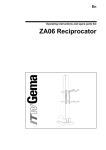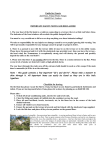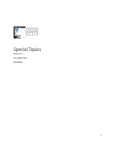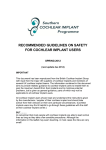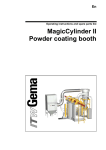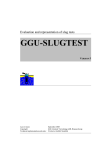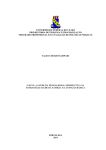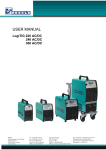Download DenguEcon User Manual
Transcript
Software to estimate the economics of a dengue vaccination program from the perspective of the health care system DDenguEcon 1.0 Beta Test VersionenguEcon 1.0 Beta Test Version TABLE OF CONTENTS Page ACKNOWLEDGMENTS ...................................................................................................................... 1 Authors…….……………………………………............1 Suggested citation………………………………………1 DISCLAIMERS ...................................................................................................................2 SYSTEM REQUIREMENTS ..............................................................................................3 LOAD AND START ...........................................................................................................4 AUTORECOVER ................................................................................................................7 INTRODUCTION ...............................................................................................................8 Background: two guiding principles ........................................................................8 METHODS ..........................................................................................................................9 Equation: Cost-effectiveness ratio: Non-fatal outcomes: .......................................9 Equation: Cost-effectiveness ratio: deaths: .............................................................9 Study perspective ...................................................................................................10 Discount rate .........................................................................................................11 How to enter data ...................................................................................................12 DATA ENTRY Page 2 of 13: Population ........................................................................................13 Page 3 of 13: Rates of non-death outcomes ...........................................................14 Type of outcome………………………………………...........14 Combined data…………………………………………..........14 Unit of rate…….………………………………………...........14 Type of outcome………………………………………...........14 Type of rate: Excess rates..……………………………...........14 Data (rates) ..…………………………….................................14 Rules for data entry……………………………………...........15 Page 4 of 13: Modeling the burden of dengue .......................................................16 Data Simulation Option .............................................................................17 Pros and Cons of Simulation......................................................................18 Page 5 of 13: Rates of deaths .................................................................................19 Page 6 of 13: Cost person treated ..........................................................................20 Outpatient………………………………………….…...........20 Inpatient………………………………………….…..............20 ii # of outpatient visits …………………………….…..............21 Page 7 of 13: Vaccine effectiveness ......................................................................22 Example (default values)………………….……….….............22 Assumed probabilities…………………………….…..............22 Limitations of methodology……………………….….............22 Page 8 of 13: Cost person vaccinated ....................................................................23 Why Upper and Lower?………………………….…...............23 Side effects………….…………………………….…..............23 Assumed compliance………….…….…………….…..............24 Page 9 of 13: Discount rate ....................................................................................25 RESULTS ..........................................................................................................................26 Page 10 of 13: Summary Input Graphs ..................................................................26 Page 11 of 13: Net $/ case or deathaverted (without simulation) .........................27 What do these graphs mean? .....................................................................27 Total $ vaccination effort….……………………….…..............27 Additional results…………...……………………….…............28 Page 12 of 13: Net $/ case or deathaverted (with simulation) .............................29 What do these graphs mean?……………………….…..............29 Total $ vaccination effort….……………………….…..............29 Additional results…………...……………………….…............30 Page 13 of 13: Sensitivity analysis ........................................................................31 Built-in sensitivity analysis…………………….…......................31 What additional sensitivity analyses can a user do?.....................31 Example: Graph of sensitivity analysis……………….................31 Most influential variables…………………….….........................31 ADDITIONAL COMMENTS ...........................................................................................33 What about herd immunity?…………………….…......................33 Reduction in Vector Control Costs?......... ……………….............33 REFERENCES ..................................................................................................................34 SUGGESTED READINGS ...............................................................................................34 COPYING AND PRINTING ............................................................................................35 CONTACT.........................................................................................................................36 iii ACKNOWLEDGMENTS AUTHORS: Martin I. Meltzer1, Mark E. Beatty2 and Rebekah Heinzen Borse1 1Centers for Disease Control and Prevention, U.S. Department of Health and Human Services, Atlanta, GA 2 Pediatric Dengue Vaccine Initiative, International Vaccine Institute, SNU Research Park, San 4-8 Bongcheon-7-dong, Kwanak-gu, Seoul, Korea 151-919 SUGGESTED CITATION: Martin I. Meltzer, Mark E. Beatty and Rebekah H. Borse. DenguEcon 1.0: a manual to assist country and district public health officials in estimating the cost effectiveness of a dengue vaccination program (Beta test version). Centers for Disease Control and Prevention, U.S. Department of Health and Human Services; 2008. THANKS Charisma Atkins, CDC, Atlanta, and Ole Wichmann, PDVI/IVI, Seoul COVER PHOTO: Electron image of mature Dengue-2 virus particles replicating in five-day-old tissue culture cells. The original magnification is 123,000 times. (available at http://www.cdc.gov/ncidod/dvbid/dengue/electron-micrograph.htm) DATE of this draft: May 25, 2009 1 DISCLAIMERS The numbers generated through DenguEcon are not to be considered absolute forecasts of the cost-effectiveness of a dengue vaccination program. Rather, they should be treated as estimates with degrees of uncertainty (which may or may not be known). The methodology, findings and conclusions in this manual, any accompanying appendices and results generated by the software (DenguEcon) are those of the authors and do not necessarily represent the views of the author‟s sponsoring agency. This version is a beta test version. As such it has not been officially cleared. 2 SYSTEM REQUIREMENTS DenguEcon uses the Windows* operating system (Microsoft Windows 2000 or higher) and Excel (Microsoft Office 2000 or higher). We recommend using a computer with at least a 486 Pentium processor and at least 128MB RAM. DenguEcon requires up to 4.1 megabytes of storage space on the computer‟s hard drive. *Microsoft Windows and Office are copyrighted products produced by Microsoft Corporation, WA. Use of trade names and commercial sources is for identification only and does not imply endorsement by the U.S. Department of Health and Human Services. 3 LOAD AND START Before loading and starting DenguEcon, you must make sure Excel‟s security level is set appropriately. You must first do the following steps: 1). Open a blank Excel spreadsheet. 2). Click Tools and then click Macro, choose Security. (Continued on next page) 4 3). In the “pop-up” box that will appear see below), set Security Level to Medium. 4). Click OK. (Continued on next page). 5 5). Go to the drive/ location where you have saved the copy of DenguEcon (e.g. C; Drive). Double click on the file, which will open DenguEcon. 6). As the computer is loading Excel (if it is not already loaded) and DenguEcon, a window will pop-up (see figure below), asking you if you want to Disable Macros or Enable Macros. Select/ click Enable Macros. DenguEcon will then fully load, and you will be ready to start. 6 AUTORECOVER Changing Excel's AutoRecover time: Excel software contains an AutoRecover feature, which essentially automatically backs-up, at pre-set intervals, a copy of an open workbook. This reduces the risk of work being lost should there be a problem with either the software or hardware that causes Excel to malfunction (e.g., "crash"). When the AutoRecover feature automatically starts, all other functions in the workbook are temporarily frozen. With large workbooks, which can take a few minutes to back-up, this can mean an inconvenient halt to working. To reduce the number of potentially frustrating halts in the flow of work, users may wish to consider altering the default value of 10 minutes between each AutoRecover. To do so, change the interval between automatic file back-ups as follows: 1. On the Tools menu in Excel, click Options, and then click the Save tab. 2. Select the Save AutoRecover info every check box. 3. In the minutes box, specify how often you want your Excel program to save files (e.g., 20 minutes). We strongly suggest that users do NOT select the "disable AutoRecover" feature. 7 INTRODUCTION Estimating the economics of a dengue vaccination program requires combining four types of data. First, we need data recording who becomes clinically ill with dengue, and the consequences of such illnesses (i.e. epidemiological data). We also need data that measures the effectiveness of the vaccine. The effectiveness of the dengue vaccine is defined as the reduction in the incidence of dengue amongst people who have received the vaccine compared to the incidence in unvaccinated people. As no vaccine is currently available we suggest using effectiveness estimates from similar vaccines such as the yellow fever vaccine.. We also need cost data recording the cost of treating patients who become ill with dengue infections and receive medical care, and, finally, we need data recording the cost of vaccination (and not just the cost of the vaccine in a vial). In other words, we also need the cost to pay the staff that administer the vaccine, pay for any additional supplies and as well as the cost of any negative vaccine side-effects. The methodological concepts that are embedded in DenguEcon, therefore, focus on how to combine these four data elements in as simple a manner as possible, but still provide a realistic “picture‟ of the cost-effectiveness (cost per case averted or cost per death averted) BACKGROUND TO METHODOLOGY: TWO GUIDING PRINCIPLES First guiding principle: Include variability of input data: A model for calculating costeffectiveness of dengue vaccination must allow for the variability in the four types of data used. Second guiding principle: useful to intended audience: Any model/ software developed must be sufficiently simple so that the intended audience (practicing public health officials) can readily use it, and readily interpret input and output values. The intended audience must be able to use the model without using specialized software, programming skills or having advanced knowledge of statistics. The methodology of combining these four types of data must allow for the fact that, biologically, the impact of dengue varies greatly from year-to-year (or, season-to-season) with large outbreaks. Furthermore an approved vaccine for dengue is not currently available. Therefore, the methodology must explicitly include allowances for the variability of the effectiveness of proposed dengue vaccines and the inevitable variability in costs (both of treating dengue-related illnesses and dengue vaccination). Thus, the methodology used in DenguEcon explicitly and deliberately allows for simultaneous variability in most of the input variables. The mathematical principles used in the construction of DenguEcon are similar to those used in Meltzer MI, Neuzil KM, Griffin MR, Fukuda K. An economic analysis of annual influenza vaccination of children. Vaccine 2005;23:1004-1014. Meltzer et al (2005), in order to allow for the variability in input data (i.e., incorporate the first guiding principle), 8 used a Monte Carlo methodology. That methodology samples probability distributions of input values (i.e., mathematically incorporates/ allows for variability of input values). However, Monte Carlo methodology requires a great deal of data (to construct “reasonable” probability distributions of input values), as well as ownership and understanding of specialist statistical software. In this software, in order to satisfy both guiding principles, instead of using Monte Carlo sampling methodology, we used a “bootstrap” methodology. This methodology resamples several hundred times a small dataset of input values (e.g., 5 data points) to build a larger data set. A probability distribution of input data values is built from this larger dataset, (see Methods section for further technical details). This building of a probability distribution of input values, even when the input dataset is small, allows for variability in input values. Further, the re-sampling is automatically programmed into the spreadsheets, and the user does not have own specialized statistical software. Thus, this methodological approach of “bootstrapping” meets the two principles guiding the design of the DenguEcon. METHODS DenguEcon is written (constructed) in Microsoft Excel/Visual Basic. Equation: Non-fatal outcomes (e.g., outpatient visits and/ or hospitalizations): The cost-effectiveness ratio in the model/ software is calculated as follows: Equation (1): Cost / case averted = Cost of vaccination program – (Cases averted X cost of treating a case) Cases averted Where: Cases averted = Rate of cases (per unit population) X population (per unit population) X vaccine effectiveness Cost of vaccination program = Total cost to vaccinate one person X population X percentage compliance 9 “case” here could be an outpatient only, a hospitalized patient only or a combination of both. “population” here refers to a given age and risk group, defined by the user, that is the focus of an analysis done using DenguEcon (see also “Methods: Page 2 of 10, below”). “per unit population” refers to the standardized unit used to measure the health outcome(s). For example, number of outpatient visits per 10,000 population. When using equation (1) DenguEcon is coded to automatically adjust the population to the same unit used to measure rates. Equation: Deaths: The cost-effectiveness ratio in the model/ software is calculated as follows: Equation (2): $/ death averted = Cost of vaccination program – (Cases averted X $ treating a case) deaths averted Where: Cases averted = Rate of cases (per unit population) X population (per unit population) X vaccine effictiveness Cost of vaccination program = Total cost to vaccinate one person X population X percentage compliance Study perspective: DenguEcon calculates the cost-effectiveness ratios, using the equations outlined above, from the perspective of the health care system. That is, how much will the health care system pay for vaccinating a target population, how much will the health care system save from such a vaccination strategy, and what will be the net cost (or savings) per case (or death) averted. This perspective was chosen because the intended audience is practicing public health officials, working in countries (e.g., member states of the Southeast Asian Region Office (SEARO)) that typically have centralized, government-funded health care systems. Broader societal considerations, such as work days lost to dengue, and gained/ saved due to dengue vaccination, are not considered under this perspective. This is important because the calculated cost-effectiveness ratios will be underestimates... 10 Time horizon considered: Current data from vaccine trials suggest two doses of vaccine separated by a 6 month interval will most likely provide at least 10 years (and possibly lifetime) protection. DenguEcon evaluates the costs and benefits of vaccinating a cohort over a 10 year period, with vaccination occurring/ completed at the beginning of Year 1, and benefits (i.e., disease averted) accruing for 10 years. Discount rate: In a situation of limited resources, societies, and even individuals, have a preference for consuming now versus delaying consumption to a future date. That is, there is a cost associated with delaying use of resources. This time preference means that $1 available today is valued more than $1 available in 10 years time. In order to be able to directly compare $1 now versus $1 received ten years from now, the $1 that will be received 10 years from now is discounted to the current year (i.e., discounting allows an “apples-to-apples” comparison of costs and benefits that occur in different years). So, at a 3% annual discount rate, society is essentially indifferent, or values equally, $1 received 1 year from now or $0.97 received now. It should be noted that all benefits and all costs should be discounted – such as costs of future vaccinations, or treatments, or cases averted. Note that a discount rate of "0%" essentially indicates no discounting is done. DenguEcon allows the user to use any discount rate desired. What is an appropriate discount rate? Appropriate discount rates can differ by perspective. In analyzing, for example, a domestic project funded by the U.S. Federal Government, the Office of Management and Budget (http://www.whitehouse.gov/omb/) currently recommends using a discount rate of approximately 3% per year. This rate is largely derived from the interest rate for 30 year U.S. treasury bonds, after adjusting (i.e., removing) the inflation effect,. DenguEcon users in other countries may wish to consider using other rates, commensurate with factors such as population growth rates and government bond market rates. Also, different perspectives, such as private versus public, can result in users selecting different discount rates Discount rate; Sensitivity analysis: We recommend that DenguEcon users, as part of their sensitivity analyses, explore the impact of using different discount rates. 11 METHODS: DATA INPUT HOW TO ENTER DATA In DenguEcon, data should only be entered in the boxes/ cells outline with bold black borders. 12 DATA TO BE ENTERED Page 2 of 13 Population being considered for vaccination Age group evaluated: Enter the age group (in years) of the population being studied. For example, 9 to 16 year old children and adolescents. If the user desires to compare different implementation strategies (e.g. EPI alone versus a catch-up campaign) we suggest that you either open different copies of the model or rerun the model with the appropriate age groups, costs, doses and effectiveness rates. A DenguEcon Supplement has been developed to compare these different options. Number in target pop. (population): Enter the number of people in the population being studied. Study perspective: The only perspective that DenguEcon uses is that of the health care system (see earlier). 13 DATA TO BE ENTERED Page 3 of 13 Rates of non-death dengue-related health outcomes Background: The data entered in this page records the rates of dengue-related health outcomes, such as outpatient visits and inpatient stays (hospitalizations). Type of dengue health outcome: The user indicates/ selects the type of non-fatal health outcome data that will be used in the analysis (see figure below). The user must enter „yes‟ (without the quotation marks) in one (and only) one of the three boxes. In the other two boxes, the user must enter „n/a‟ (without the quotation marks). The abbreviation, „n/a‟, means not applicable. Combined inpatient and outpatient data: DenguEcon can “accept” data that combines the rates of outpatient and inpatient dengue-related health outcomes. For example, a rate of outpatient visits of 550 per 100,000 + a rate of hospitalizations of 10 per 100,000 gives a combined rate of 560 health outcomes per 100,000. Note that, in order to combine outcomes correctly, the user must first ensure that both rates are recorded in the same measure of unit population (e.g., both rates record per 100,000 population, or whatever is the most convenient rate). Unit of rate: Record here the unit of rate for the data that will be entered (e.g., per 100,000 population being studied). DATA (RATES): In these cells, a user enters the actual data (see diagram below), in the form of rates per unit population (the unit having already being recorded – see “Unit of rate,” above). 14 RULES FOR DATA ENTRY: i) For DenguEcon to work, you need to enter a minimum data for 5 consecutive years. If no cases are reported in a given year, then enter "0" ii) If you only have 5 years of consecutive data, or less than 10 years of data, then leave the remaining 5 years blank. iii) Years/ seasons entered here must match seasons entered into "Deaths" input sheet 15 DATA TO BE ENTERED Page 4 of 13 Modeling the burden of dengue: User has two options: CHOOSE one of the following: It was assumed, when constructing DenguEcon, that many users will not have, readily available, 10 years of national dengue surveillance data. However, dengue is a disease of epidemic potential and therefore its impact varies greatly comparing outbreak and non outbreak years. Outbreaks typically occur at 3-8 year intervals in endemic countries. Incidence of severe disease can also vary based on the genotype of the prevalent virus serotype and prior exposure to dengue, and the serotype of the previous infecting strain. Figure. Variation in total cases, incidence, and laboratory-positivity rate of dengue cases in Puerto Rico 1963 to 2003 (Source J. Rigau. Americas Dengue Prevention Board Meeting. Mexico City Jan 17-20, 2008) Therefore, a descriptive statistic, such as the “average” rate of health outcome would often be misleading. A single outbreak year could greatly increase the estimate of the average health outcomes. Similarly, the estimate of an average could be influenced by the inclusion of one or two years which are atypical and “unusually mild” due to environmental conditions or improved prevention activities. Thus, if a user has only five years worth of data, the calculated average cost-effectiveness ratio can vary greatly, depending on which 5 years are measured. 16 Conclusion: Having less than 10 years worth of data could create an inaccurate probability distribution describing the rates of health outcome (i.e., the small data sets that are likely to be available will not reliably record the probability of a given rate of health outcome occurring) Thus, in order to reduce potential biases in probabilities caused by having only 5 – 10 years of data, DenguEcon uses a statistical technique called “bootstrapping” to “amplify” the number of measurements available to record the probability of health outcome rates occurring. Data Simulation Option: Therefore, on this page, the user is given the choice to use the dengue incidence data as entered for 10 years (option 1) to estimate the cost effectiveness, or use the boot strapping to simulate 10 years of dengue incidence data if 10 full years is not available (option 2). If the user selects the simulation option, option 2, DenguEcon randomly selects/ samples four years worth of data. DenguEcon uses a system of sampling called “sampling with replacement,” which means that it is possible (but very unlikely) that a single year will be selected 4 times. It then calculates the average for those years, and places that average in a separate column. DenguEcon does this random sampling 150 times. The result is a column of 150 averages. With 150 data points, DenguEcon then calculates the cumulative probability distribution of the excess health outcome rates, including the 5th and 95th, percentiles, the median, average, minimum and maximum values. If the user selects the simulation option, the user must first enter the minimum number of years between peak or outbreak years. Typically outbreaks occur in endemic areas every 3 – 8 years. Then the user must select the option 1 or 2. In either case, a graph displaying the annual incidence entered on page 2 of 13 is shown on the left. If simulation is chosen, the graph on the right displays the results of the simulation. By hitting the “F9” key the user can see other examples of the data using simulations. If simulation (Option 2) is to be chosen, enter the minimum years between peak or outbreak years HERE Choose no simulation (Option 1) or simulation (Option 2) HERE. 17 Pros and Cons of Simulation: The “pros” of such a system is that the simulation model “amplifies” small sets of data and provides a more stable probability distribution. The “cons” of such a system is that the technique ignores possible biologically important factors that may determine the actual, “real life” probability distribution. For example, in a given year, the rate of health outcomes may have been influenced by the rate in the previous year(s). The degree of such year-to-year correlation and influence is unknown, and thus it is unknown how important it is to have such year-to-year correlation included in the construction of a “bootstrapped” probability distribution. 18 DATA TO BE ENTERED Page 5 of 13 Rates of deaths due to dengue This data entry page is the same in concept, and has the same elements, as Page 3 of 13 (Rates of non-death dengue-related health outcomes). The explanation of each of the data entry elements required is the same as for Page 3 of 13, with the difference that in this data-entry page, the rates entered must measure the excess rate of deaths due to dengue. 19 DATA TO BE ENTERED Page 6 of 13 Cost per person treated: In- and outpatients NOTE: Costs are marked in “$” terms. However, the user can enter cost data in any currency desired. The only rule is that all cost data must be entered in the same currency. Outpatient $: This column of data records the cost of an outpatient visit for denguerelated illness. The categories in this column (cost / visit, cost / drugs, cost / other) are suggested cost elements that analysts and policy makers may be interested in recording. However, there is no absolute set rule as to what should be recorded in this column. Technically, what is needed is a number recording the cost to the health care system (the perspective of DenguEcon – see earlier) of treating an outpatient for dengue. Such estimates should follow “good accounting practices, and record all expenditures of delivering appropriate treatment to a patient. Such costs would include physician and nurse time (salary and wages), salary for any clinic administrators, cost of supplies, medicines, treatment, and laboratory tests, overhead to operate a clinic or hospital (e.g., utilities, building repairs and maintenance, etc.). The detail entered into DenguEcon is dependent upon the user. It may well be, for example, that a DenguEcon user can readily obtain an estimate of total cost, but not a breakdown of costs. In that case, the user would simply enter the total cost in the cell “cost / visit,” and leave the other cells in the column as “$0.” A user may, for example, find it easier to estimate cost of a health care visits in a separate sheet and just enter the sum total (in the “cost / visit” cell). Inpatient $: This column records all the costs of treating an inpatient for dengue-related illnesses. As in the outpatient cost column, there is no absolute set rule as to what should be recorded in this inpatient cost column. Technically, what is needed is a number recording 20 the cost to the health care system (the perspective of DenguEcon – see earlier) of treating an inpatient for dengue. The detail entered into DenguEcon is dependent upon the user. It may well be, for example, that a DenguEcon user can readily obtain an estimate of total cost, but not a breakdown of costs. In that case, the user would simply enter the total cost in the cell “cost / day per hospital bed,” and leave the other cells in the column as “$0.” # outpatient visits: It is realistic to assume that an inpatient may also have had an outpatient visits before and possibly after (for follow-up) an inpatient stay. However, the user must ensure that, if a number of outpatient visits associated with an inpatient stay are entered in this column, then those outpatient visits are REMOVED from the rate of outpatient data (Page 3 of 10). In many instances, it is likely that a user will not be able to identify which outpatient visits (if any) are associated with an inpatient stay. In such situations, in order to avoid any double accounting, the user MUST enter „0” visits in the “# outpatient visits” in this column of costs for inpatients. # of outpatients per inpatient: If, in data entry Page 3 of 10 (Rates of non-death dengue-related health outcomes), you entered combined outpatient and inpatient data, then you MUST enter the approximate number of outpatient visits per inpatient hospitalization. 21 DATA TO BE ENTERED Page 7 of 13 Effectiveness of dengue vaccine In this page a DenguEcon user enters the assumed probabilities of vaccine effectiveness. Users are asked to enter the probability for thos who receive only one dose and the probability for those who receive both doses. Currently, there is no approved vaccine so data on the effectiveness of a tetravalent dengue vaccine is limited. Chanthavanich et al. (2006) evaluated antibody titers several years after vaccination with a tetravalent dengue vaccine; however, antibody titers are a poor correlate of protection. For this reason, DenguEcon users can vary the level of effectiveness to determine the lower limit of effectiveness that remains cost effective by running the program multiple times varying the levels of effectiveness. An example of the varying level of vaccine effectiveness is shown in the example below. What does DenguEcon do with the data? DenguEcon calculates the weighted average vaccine effectiveness. This is calculated as follows: Average vaccine effectiveness = (The effectiveness of the first dose X the percent who get only one dose) + (the effectiveness of the second dose X the percent who get both doses) Limitations of methodology: The current methodology used in DenguEcon to evaluate all the user-entered data concerning vaccine effectiveness is simple and direct. However, if does not necessarily fully utilize all the data contained in the probability distribution. Future versions of DenguEcon may contain a more sophisticated methodology for incorporating the vaccine effectiveness data. Another limitation is that vaccine effectiveness is assumed to be identical for all outcomes. 22 DATA TO BE ENTERED Page 8 of 13 Cost per person vaccinated Cost / person vaccinated: Lower & Upper: In these two columns, the DenguEcon user enters upper and lower estimates of the cost of vaccinating one person against dengue. The guiding principle in this data entry sheet is that the cost of vaccinating a person is a great deal more than just the cost of the vaccine. Indeed, delivering the vaccine to the clinic, and assembling all the elements to administer that vaccine (physician and nurse time, syringes, clinic overhead, etc.) may be more costly than the actual purchase of the vaccine. As in the other cost data entry pages (Page 6 of 13), the categories in this column (vaccine physician, nurse, etc., etc.) are suggested cost elements that analysts and policy makers may be interested in recording. Again, if a user only has, at least initially, a total estimate, that incorporates all the costs without a breakdown, the user can merely enter that total cost in the row labeled “Vaccine,” and enter $0 for all other elements. WHY two columns – “Lower” and “Upper”? Lower and upper estimates do not necessarily have to represent minimum and maximum range of potential cost. However, it is realistic to assume that, over time and by locale, costs will likely vary. This potential for variability must be explicitly modeled. Side effects: Adverse events may occur with dengue vaccination (i.e., patients can experience harmful side effects). The vast majority of recorded side effects tend to be of a “minor nature,” such as soreness at the site of vaccination. However, some side effects can be serious and, very rarely, life threatening. Such serious side effects require medical attention and therefore represent a cost associated with vaccinating a patient. The costs associated with treating these serious side effects, no matter how rare, should be explicitly accounted for. In this page, two types of side effects are accounted for - mild side effects and anaphylaxis. For either side-effect, the user enters the probability of such a side effect (in column “Probability”) and the cost of treating one case of that side effect (in column “$ treat”). DenguEcon then calculates the average cost-per-person vaccinated for treating either type of side effect, as follows; Cost per person vaccinated for treating side effect = probability of side effect x $ treating person with side effect. DenguEcon then sums up the three costs (per person vaccinated) and this sub-total is then automatically entered into the columns totaling cost per person vaccinated (both lower and upper estimate columns receive the same estimate for treating side effects). 23 Assumed compliance: Enter the assumed percentage of persons in the target population (identified on Page 2 of 13) that will be successfully vaccinated against dengue in a given year. The range of possible entry values is from 0% to 100%. 24 Page 9 of 13 Discount rate On this page the user is allowed to enter the discount rate for benefits accrued for dengue vaccination up to ten years in the future. The Office of Management and Budget of the U.S. government uses a discount rate of 3% (http://www.whitehouse.gov/omb/circulars/a094/a094.html), but higher discount rates may be appropriate in developing and transitional economies. What is a “discount rate?” In a situation of limited resources, societies, and even individuals, have a preference for consuming now versus delaying consumption to a future date. That is, there is a cost to delaying use of resources. This time preference means that $1 available today is valued more than $1 available in, say, 10 years time. In order to be able to directly compare $1 now versus $1 received ten years from now, the $1 that will be received 10 years from now is discounted to the current year (i.e., discounting allows an “apples-to-apples” comparison of costs and benefits that occur in different years). It should be noted that all benefits and all costs should be discounted – such as costs of future vaccinations, or treatments, or cases averted. Entering “0” is also an option. Note that a discount rate of "0%" essentially indicates no discounting is done. 25 RESULTS Page 10 of 13 Results: Summary user-entered inputs This page summarizes the input data. These graphs are provided so that a DenguEcon user has a convenient method of displaying some of the critical input data. These graphs can be copied and pasted into presentations and reports. 26 RESULTS Page 11 of 13 Results without Simulated Rates (Option 1): Net cost / case or death averted This page provides two graphs depicting the cost-effectiveness accrued over 10 years after vaccinating a cohort of persons in the target group (defined on Page 2 of 13) against dengue in a single year when the user has a full 10 years of incidence data (therefore chooses Option 1 on page 4 of 13 (no bootstrapping is needed to estimate a full 10 years of data). The equations used to calculate the data depicted in these graphs are provided earlier in this manual (Methods: page 8). The graph on the left depicts to cost-per case averted, where a case may be inpatient (only), outpatient (only) or combined (inpatient + outpatient). The definition of what type of case is depicted in the graph depends upon the data entered in Page 2 of 13. The graph on the right depicts the cost-per-death averted. What do these results “mean?” On the X-axis, along the bottom of each graph, is a range of $/ person vaccinated. This range encompasses the range of costs of vaccinating a person entered by the user on Data Entry Page (note that if the user changes the range of costs in Data Entry Page 8 of 13, the range in the graph may change). On the y-axis is the cost-effectiveness ratio, either “$/case averted” (left hand graph), or “$/ death averted” (right hand graph). The solid line in each graph indicates the median cost-effectiveness ratio, whilst the two dotted lines represent the 5th and 95th confidence intervals. In each graph, any time any results (a line, or part of a line) are above the $0/ case averted or $0/death averted, that means that dengue vaccination results in a net cost to the health care system. In order for there to be a net savings (per case or death averted) to the health care system, the line must be below the $0/ case averted (i.e., read as -$/ case averted). # persons vaccinated: Displays the number of persons assumed vaccinated (“Total target population” from Page 2 of 13 multiplied by the” % compliant with at least one dose of vaccine,” page 8 of 13). Total $ of vaccination effort (1 year): Shows the estimated (lower and upper) costs of vaccinated the target population. These estimates are calculated as follows: Cost of vaccination campaign (1 year) = cost of vaccinating 1 person X number of persons vaccinated. The costs of vaccinating 1 person are derived from Data Entry Page 8 of 13. 27 Additional results: By scrolling down below the graphs, the user will find two tables in which additional, more detailed results of the cost-effectiveness analyses can be found. Each table provides, from the 5th to 95th percentile, the number of cases (deaths) averted, the costs saved by the health care system (before considering costs of vaccination), and the cost-effectiveness ratios, expressed in terms of the lower and upper limits of the cost of vaccination (as defined in DATA Entry Page 8 of 13). 28 RESULTS Page 12 of 13 Results with Simulated Rates (Option 2): Net cost / case or death averted This page provides two graphs depicting the cost-effectiveness accrued over 10 years after vaccinating a cohort of persons in the target group (defined on Page 2 of 13) against dengue in a single year when the user does not have a full 10 years of incidence data and chooses Option 2 on page 4 of 13 to use the bootstrapping method estimate a full 10 years of data based on the available data. The equations used to calculate the data depicted in these graphs are provided earlier in this manual (Methods: page 8). The graph on the left depicts to cost-per case averted, where a case may be inpatient (only), outpatient (only) or combined (inpatient + outpatient). The definition of what type of case is depicted in the graph depends upon the data entered in Page 2 of 13. The graph on the right depicts the cost-per-death averted. What do these results “mean?” On the X-axis, along the bottom of each graph, is a range of $/ person vaccinated. This range encompasses the range of costs of vaccinating a person entered by the user on Data Entry Page (note that if the user changes the range of costs in Data Entry Page 8 of 13, the range in the graph may change). On the y-axis is the cost-effectiveness ratio, either “cost /case averted” (left hand graph), or “cost / death averted” (right hand graph). The solid line in each graph indicates the median cost-effectiveness ratio, whilst the two dotted lines represent the 5th and 95th confidence intervals. In each graph, any time any results (a line, or part of a line) are above the $0/ case averted or $0/death averted, that means that dengue vaccination results in a net cost to the health care system. In order for there to be a net savings (per case or death averted) to the health care system, the line must be below the $0/ case averted (i.e., read as -$/ case averted). # persons vaccinated: Displays the number of persons assumed vaccinated (“Total target population” from Page 2 of 13 multiplied by the” % compliant with at least one dose of vaccine,” page 8 of 13). Total $ of vaccination effort (1 year): Shows the estimated (lower and upper) costs of vaccination of the target population. These estimates are calculated as follows: Cost of vaccination campaign (1 year) = cost of vaccinating 1 person X number of persons vaccinated. The costs of vaccinating 1 person are derived from Data Entry Page 8 of 13. 29 Additional results: By scrolling down below the graphs, the user will find two tables in which additional, more detailed results of the cost-effectiveness analyses can be found. Each table provides, from the 5th to 95th percentile, the number of cases (deaths) averted, the costs saved by the health care system (before considering costs of vaccination), and the cost-effectiveness ratios, expressed in terms of the lower and upper limits of the cost of vaccination (as defined in DATA Entry Page 8 of 13). 30 Page 13 of 13 Results: Sensitivity analyses Built-in sensitivity analyses: When user selects Option 2 on Page 4 of 13 to compensate for small data sets recording dengue-related health outcomes, DenguEcon is programmed to repeatedly sample (150 times) the small set of the recorded health outcome rates, producing a large number of possible average health outcomes. This built in methodology is a form of sensitivity analysis. Further, the model allows a user to make a ready and rapid examination of the impact of changes in most of the input variables. For example, the user can readily make changes in vaccination costs, rates of health outcomes, vaccine effectiveness, population under study (by age, risk groups, size, etc.), as well as changes in cost of vaccination. What sensitivity analyses can a user do? The user is encouraged to extensively explore the impact of making many changes in input values, and is particularly encouraged to make several changes at the same time to different variables (this is called "multi-variable sensitivity analyses"). A user can produce any number of multi-variable sensitivity results by collecting the results, produced by each new combination of input values, from the detailed results tables in the "Results" sheet (scroll down below the results graphs). Example: The sensitivity analyses graph on Page 13 of 13: On Page 13 of 13, there is an example of a graph produced by running DenguEcon several times. This graph illustrates how step-wise changes in vaccine effectiveness impacts the cost-effectiveness ratio for two different costs of vaccination. Essentially the graph illustrates how fixed increases in vaccine effectiveness can reduce the cost-effectiveness ratio (i.e, $/ case averted becomes less costly as vaccine effectiveness increases). The graph contains 3 different types of data: i) two costs of vaccination; ii) range of vaccine effectiveness; and, iii) resultant cost-effectiveness ratios. The data for the graph were obtained by first fixing the weighted average vaccine effectiveness on Data Entry Page 7 of 13, and the recording the resultant median (50th percentile) cost effectiveness ratios from the detailed tables of results (Results page 11 or 12 of 13). The process is repeated a number of times, each time entering a different estimate of vaccine effectiveness. Note that, in order to keep the graph “clean and simple,” I have chosen to omit any confidence intervals (i.e., the 5th and 95th percentiles are not drawn in - but they could be added if the user so wishes). Interpreting the results: determining which variables are most influential: By looking at the graph in the sensitivity analysis page (Page 13 of 13), and the graphs in the results page (Page 11 or 12 of 13), a user can begin to see which variables (within the range of values examined) are most influential. For example, in the sensitivity analysis 31 (drawn from results produced using the illustrative data) on Page 13 of 13, we note that if there is a 6-fold increase in the cost of vaccination, then the cost effectiveness ratio essentially doubles. But, as vaccine effectiveness increases from 50% to 90% (an 80% increase), we note that the cost-effectiveness ratio only at a much lower rate. Thus, a user can conclude that the results, derived from the illustrative default data, are more sensitive to changes in the cost of vaccination than changes in vaccine effectiveness. That is, in terms of cost-effectiveness (and within the range of values examined), cost of vaccination is more influential than vaccine effectiveness. Of course, entering in other data may change that conclusion. 32 ADDITIONAL COMMENTS What about herd immunity? Herd immunity was not included in this version of DenguEcon because without an approved vaccine there is no way to predict the level of herd immunity that will be achieved. If included, herd immunity would improve the cost effectiveness through the added benefits accrued through the prevention of disease in persons who were not vaccinated. We therefore assumed a conservative stance and did not include the potential for herd immunity in this model. Reduction in Vector Control Costs? When considering the cost effectiveness of a proposed dengue vaccine, the potential for additional saving through the reduced need for dengue vector control was considered. If an effective dengue vaccine is introduced, vector control will likely continue at least until adequate vaccine coverage in the population is achieved. Even then, equipment and personnel used for dengue vector control are often shared for the control of other vectors and therefore reduction of routine operating budgets seem unlikely to occur. One could argue that excess budget spent during dengue outbreaks on vector control could represent a true savings; however, this benefit will occur until adequate vaccine coverage in the population is needed. The time required to achieve that coverage may be greater than 10 years. Again we adopted a conservative point of view and did not include the potential for saving from reduced need for dengue vector control or the prevention of outbreaks. 33 REFERENCES Chanthavanich P, Luxemburger C, Sirivichayakul C, Lapphra K, Pengsaa K, Yoksan S, Sabchareon A, Lang J. Short report: immune response and occurrence of dengue infection in thai children three to eight years after vaccination with live attenuated tetravalent dengue vaccine. Am J Trop Med Hyg. 2006 Jul;75(1):26-8. Meltzer MI, Rigau-Pérez JG, Clark GG, Reiter P, Gubler DJ. Using disabilityadjusted life years to assess the economic impact of dengue in Puerto Rico: 19841994. Am J Trop Med Hyg. 1998 Aug;59(2):265-71. Meltzer MI, Neuzil KM, Griffin MR, Fukuda K. An economic analysis of annual influenza vaccination of children. Vaccine 2005;23:1004-1014. SUGGESTED READINGS Haddix AC, Teustch SM, Corso PA (eds). Prevention effectiveness: A guide to decision analysis and economic evaluation (2nd edition). Oxford, UK: Oxford WHO Definition. DALY: http://www.who.int/healthinfo/boddaly/en/ The World Bank (1996). The disability-adjusted life year (DALY) definition, measurement and potential use. Human capital development and operations policy working papers ; no. HCD 68, 1996/07/31. 34 COPYING AND PRINTING Copying: Any Page, Table or Graph in DenguEcon can be copied and pasted to another Excel-compatible program application (e.g., for presentations or report writing), using standard procedures. Most of the time, a page or table or graph can be copied and pasted by first selecting the area/ graph needed to be copied, right clicking on the mouse to produce a menu and selecting “copy” from the menu. The copied object can then be pasted in the new application as need (by clicking the right button in the mouse, and then selecting “Paste”). For more information, please consult Excel‟s online help or a manual for Excel. Printing: In order to print your results on a single page, you may need to change the printing page setup to Landscape format. To do so, 1). Click File and then choose Page Setup. 2). In the Orientation section, change Portrait to Landscape. 3). Click OK. 35 CONTACT For additional help or feedback, please email your comments or questions to Martin I Meltzer M.S., Ph.D. ([email protected]). 36







































